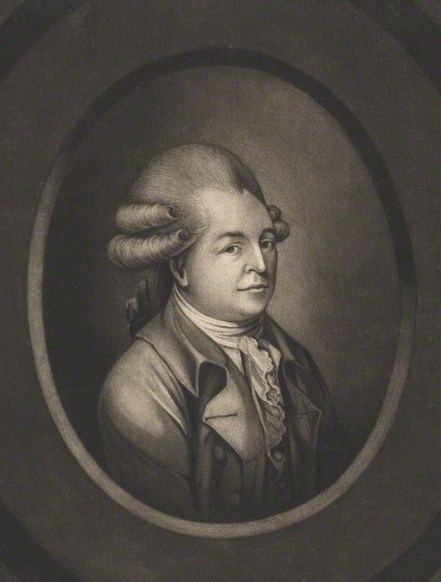Robert Laurie (c. 1755–1836) was an Anglo-Scottish mezzotint engraver and publisher. He signed his name as Lowery, Lowry, Lowrie, Lawrey, Lawrie, or Laurie.
Born about 1755, his background was the Lauries of Maxwelton, Dumfriesshire. He received from the Society of Arts in 1770 a silver palette for a drawing from a picture, and in 1773, 1775, and 1776 premiums for designs of patterns for calico-printing.
His earliest portraits in mezzotint are dated 1771. He invented a method of printing mezzotinto engravings in colours, and for its disclosure he received from the Society of Arts in 1776 a bounty of thirty guineas. Early in 1794, in partnership with James Whittle, he succeeded to the business carried on by Robert Sayer at the Golden Buck in Fleet Street, London as a publisher of engravings, maps, charts, and nautical works. Major charts published by this firm were James Cook's Survey of the South Coast of Newfoundland (1776) and the Surveys of St. George's Channel, (1777). Laurie then gave up the practice of engraving. He retired from business in 1812, and the firm continued as Whittle & Laurie, but the business was run by his son, Richard Holmes Laurie, who, on the death of Whittle in 1818, became the sole proprietor. L. S. De la Rochette and John Purdy were the hydrographers to the firm.
Robert Laurie died at Broxbourne, Hertfordshire, on 19 May 1836, aged 81. His son died at 53 Fleet Street, on 19 January 1858, also at the age of 81, leaving two daughters.
Major subject prints by Laurie were:
The Adoration of the Magi, The Return from Egypt, The Crucifixion, and St. John the Evangelist, after RubensThe Crucifixion, after VandyckThe Incredulity of St. Thomas, after RembrandtThe Holy Family, after GuercinoChrist crucified, after Annibale CarracciThe Adoration of the Magi, after Andrea CasaliThe Quack Doctor, after Christian Wilhelm Ernst DietrichThe Flemish Rat-catcher and The Itinerant Singer, after Adriaen van OstadeThe Wrath of Achilles, after Antoine CoypelA Hard Gale and A Squall, after Joseph VernetThe Oath of Calypso, Diana and her Nymphs bathing, and a Madonna, after Angelica KauffmanSunrise: landscape with fishermen, after George BarretThe Naval Victory of Lord Rodney, after Robert DoddYoung Lady confessing to a Monk, after William MillarCourt of Equity, or Convivial City Meeting, after Robert DightonThe Rival Milliners and The Jealous Maids, after John ColletThe Full of the Honeymoon and The Wane of the Honeymoon, after Francis Wheatleya scene from She Stoops to Conquer, with portraits of Shuter, Quick, and Mrs. Green, after Thomas Parkinsona scene from The School for Scandal, with portraits of Mrs. Abington, King, Smith, and Palmer, from a drawing by himself.Portraits include those of:
George III and Queen Charlotte, after ZoffanyQueen Charlotte, with the Princess Royal and Princess Sophia Augusta, and George, prince of Wales, with Frederick, duke of York, two groups after his own designsDavid Garrick, after Sir Joshua ReynoldsGarrick led off the Stage by Time towards the Temple of Fame, after Thomas ParkinsonGarrick with Mrs. Bellamy, as Romeo and Juliet, after Benjamin WilsonMrs. Baddeley, the actress, after Zoffany;Elizabeth Gunning, duchess of Argyll, two plates after Catharine ReadJemima, countess Cornwallis, after Sir Joshua ReynoldsRichard Howe, 1st Earl Howe, after Peter MequignonJohn Jervis, 1st Earl of St Vincent;Étienne François, duc de Choiseul, full-length, after Jean-Baptiste van Loo;Georgiana, Duchess of DevonshireJoseph Amesand a series of twelve portraits of actors, after Robert Dighton.

